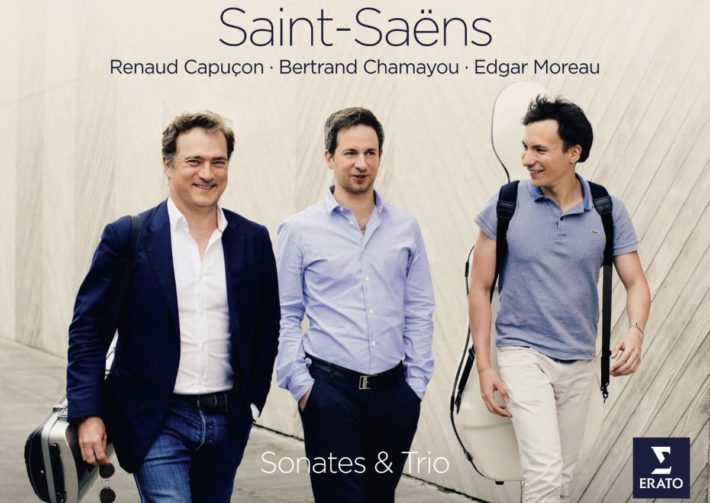Following a well-received release of Saint-Saëns’ Piano Concertos (reviewed here), pianist Bertrand Chamayou is joined by violinist Renaud Capuçon and cellist Edgar Moreau in a program of the composer’s chamber works.
The Op. 75 Violin Sonata features top-notch playing from Capuçon and Chamayou, who possess a well thought-out perspective on the piece’s narrative. They seem initially to take an understated approach in the Allegro Agitato (track 1), but considering the trajectory of the sonata, this is an insightful choice. Within the movement itself, there is a brooding suspense that both underlies and bolsters the lyrical parts: the gentle major sections contain beautiful writing from the composer and also convey the duo’s musical sensibilities. At 1:34, for instance, the violin sings with a full-bodied tone while the piano, in its delicacy, sounds like flowing water.
Throughout, the performers display a translucent sound that also highlights the dynamism of each part. This plays an integral part in the Adagio, which is both meditative and profound. Chamayou’s performance especially stands out, proving once again his special affinity with this composer: every note is attended with care and has a distinct bell-like tone. Though everything is so well-considered, the duo never gives off a measured or cautious feel: despite the attention to details, they still capture the scampering character of the third movement with an added hint of playfulness. The Allegro molto that follows picks up the momentum, bringing an exciting conclusion to the work. The restraint of the first movement is replaced with joy and passion (especially from Capuçon), so that we can finally experience the thrill that has built up through earlier moments. Chamayou adds depth and power, providing a strong basis upon which the violin shines with a flawless articulation and intonation.
Related Classical Music Reviews
- Side-By-Side Albums Review: Chamayou and Lortie Plays Saint-Saëns
- Review: Edgar Moreau Plays Offenbach and Gulda Cello Concertos
- Review: “Carnival of the Animals” – The Kanneh-Masons
The Cello Sonata is the earliest work in this program (1872). The Allegro (track 5) is dark and dramatic, but still coupled with Saint-Saëns’ refined style. Chamayou and cellist Edgar Moreau put together a performance that leaves little to be desired. Despite a chordal texture that resides largely in the lower register, the pianist upholds a mindful balance and support of his counterpart. The only thing missing, I felt, was that the cello could be more emphatic; sections like the beginning would do well to communicate more pathos. (Here, one might refer to Mischa Maisky’s recording with pianist Daria Hovora: this is a performance that really captures the movement’s vibrance).
Though this sonata was written some 13 years before the Violin Sonata, we already hear the composer experimenting with harmonic modulations – something the performers use to great effect, especially in the development. Each key’s different character builds an interesting complexity into the work. The Andante tranquillo (track 6) is all about exemplary partnership: much is built upon handoffs and repetition between the instruments. Smooth transitions and stylistic consistency of the staccato ostinato shared between piano and cello add to the nicely paced Andante. The moment that begins at 1:55 also has some beautiful melodic interchanges, with Moreau effectively maximizing the cello’s resonance.
Over 30 minutes long, you would expect the Piano Trio (Op. 92) to be the heavyweight in the program (“I am working…on a Trio which I hope will drive to despair all those unlucky enough to hear it.”, Saint-Saëns wrote). But the overall impression from the work can be uneven, maybe because of the inflation of ideas in the five movements or the thickness of the piano part, which sometimes forces the pianist to sound over-cautious. But the Andante con moto (track 10) is delightful – the strings evoke an inquisitive, voice-like quality, while the piano adds a velvety tone that brings out the movement’s romance. A sprawling fugal section drives much of the last movement, which has absolute clarity and perpetual energy.
The liner notes are a helpful addition to the presented works. The recording balance, though close and sometimes airless, presents each performer on equal dimensions but still lets individual nuances to come through.

Saint-Saëns – Violin Sonata (Op. 75), Cello Sonata (Op. 32), Piano Trio No. 2 (Op. 92)
Bertrand Chamayou – Piano
Renaud Capuçon – Violin
Edgar Moreau – Cello
Erato / Warner Classics, CD 9029516710
Saint-Saëns – Chamber Works with Piano – Recommended Comparisons
Read more classical music reviews or visit The Classic Review Amazon store
Follow Us and Comment:
[wd_hustle id=”HustlePostEmbed” type=”embedded”]











